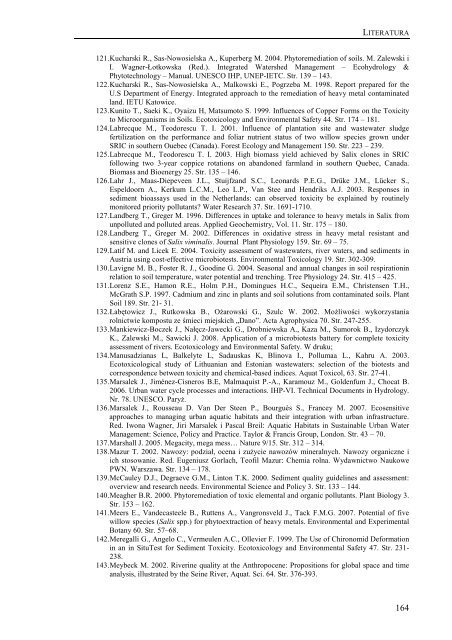optymalizacja wykorzystania osadu Åciekowego - SWITCH ...
optymalizacja wykorzystania osadu Åciekowego - SWITCH ...
optymalizacja wykorzystania osadu Åciekowego - SWITCH ...
You also want an ePaper? Increase the reach of your titles
YUMPU automatically turns print PDFs into web optimized ePapers that Google loves.
LITERATURA<br />
121. Kucharski R., Sas-Nowosielska A., Kuperberg M. 2004. Phytoremediation of soils. M. Zalewski i<br />
I. Wagner-Łotkowska (Red.). Integrated Watershed Management – Ecohydrology &<br />
Phytotechnology – Manual. UNESCO IHP, UNEP-IETC. Str. 139 – 143.<br />
122. Kucharski R., Sas-Nowosielska A., Malkowski E., Pogrzeba M. 1998. Report prepared for the<br />
U.S Department of Energy. Integrated approach to the remediation of heavy metal contaminated<br />
land. IETU Katowice.<br />
123. Kunito T., Saeki K., Oyaizu H, Matsumoto S. 1999. Influences of Copper Forms on the Toxicity<br />
to Microorganisms in Soils. Ecotoxicology and Environmental Safety 44. Str. 174 – 181.<br />
124. Labrecque M., Teodorescu T. I. 2001. Influence of plantation site and wastewater sludge<br />
fertilization on the performance and foliar nutrient status of two willow species grown under<br />
SRIC in southern Ouebec (Canada). Forest Ecology and Management 150. Str. 223 – 239.<br />
125. Labrecque M., Teodorescu T. I. 2003. High biomass yield achieved by Salix clones in SRIC<br />
following two 3-year coppice rotations on abandoned farmland in southern Quebec, Canada.<br />
Biomass and Bioenergy 25. Str. 135 – 146.<br />
126. Lahr J., Maas-Diepeveen J.L., Stuijfzand S.C., Leonards P.E.G., Drüke J.M., Lücker S.,<br />
Espeldoorn A., Kerkum L.C.M., Leo L.P., Van Stee and Hendriks A.J. 2003. Responses in<br />
sediment bioassays used in the Netherlands: can observed toxicity be explained by routinely<br />
monitored priority pollutants? Water Research 37. Str. 1691-1710.<br />
127. Landberg T., Greger M. 1996. Differences in uptake and tolerance to heavy metals in Salix from<br />
unpolluted and polluted areas. Applied Geochemistry, Vol. 11. Str. 175 – 180.<br />
128. Landberg T., Greger M. 2002. Differences in oxidative stress in heavy metal resistant and<br />
sensitive clones of Salix viminalis. Journal Plant Physiology 159. Str. 69 – 75.<br />
129. Latif M. and Licek E. 2004. Toxicity assessment of wastewaters, river waters, and sediments in<br />
Austria using cost-effective microbiotests. Environmental Toxicology 19. Str. 302-309.<br />
130. Lavigne M. B., Foster R. J., Goodine G. 2004. Seasonal and annual changes in soil respirationin<br />
relation to soil temperature, water potential and trenching. Tree Physiology 24. Str. 415 – 425.<br />
131. Lorenz S.E., Hamon R.E., Holm P.H., Domingues H.C., Sequeira E.M., Christensen T.H.,<br />
McGrath S.P. 1997. Cadmium and zinc in plants and soil solutions from contaminated soils. Plant<br />
Soil 189. Str. 21- 31.<br />
132. Łabętowicz J., Rutkowska B., OŜarowski G., Szulc W. 2002. MoŜliwości <strong>wykorzystania</strong><br />
rolnictwie kompostu ze śmieci miejskich „Dano”. Acta Agrophysica 70. Str. 247-255.<br />
133. Mankiewicz-Boczek J., Nałęcz-Jawecki G., Drobniewska A., Kaza M., Sumorok B., Izydorczyk<br />
K., Zalewski M., Sawicki J. 2008. Application of a microbiotests battery for complete toxicity<br />
assessment of rivers. Ecotoxicology and Environmental Safety. W druku;<br />
134. Manusadzianas L, Balkelyte L, Sadauskas K, Blinova I., Pollumaa L., Kahru A. 2003.<br />
Ecotoxicological study of Lithuanian and Estonian wastewaters: selection of the biotests and<br />
correspondence between toxicity and chemical-based indices. Aquat Toxicol, 63. Str. 27-41.<br />
135. Marsalek J., Jiménez-Cisneros B.E, Malmaquist P.-A., Karamouz M., Goldenfum J., Chocat B.<br />
2006. Urban water cycle processes and interactions. IHP-VI. Technical Documents in Hydrology.<br />
Nr. 78. UNESCO. ParyŜ.<br />
136. Marsalek J., Rousseau D. Van Der Steen P., Bourguès S., Francey M. 2007. Ecosensitive<br />
approaches to managing urban aquatic habitats and their integration with urban infrastructure.<br />
Red. Iwona Wagner, Jiri Marsalek i Pascal Breil: Aquatic Habitats in Sustainable Urban Water<br />
Management: Science, Policy and Practice. Taylor & Francis Group, London. Str. 43 – 70.<br />
137. Marshall J. 2005. Megacity, mega mess… Nature 9/15. Str. 312 – 314.<br />
138. Mazur T. 2002. Nawozy: podział, ocena i zuŜycie nawozów mineralnych. Nawozy organiczne i<br />
ich stosowanie. Red. Eugeniusz Gorlach, Teofil Mazur: Chemia rolna. Wydawnictwo Naukowe<br />
PWN. Warszawa. Str. 134 – 178.<br />
139. McCauley D.J., Degraeve G.M., Linton T.K. 2000. Sediment quality guidelines and assessment:<br />
overview and research needs. Environmental Science and Policy 3. Str. 133 – 144.<br />
140. Meagher B.R. 2000. Phytoremediation of toxic elemental and organic pollutants. Plant Biology 3.<br />
Str. 153 – 162.<br />
141. Meers E., Vandecasteele B., Ruttens A., Vangronsveld J., Tack F.M.G. 2007. Potential of five<br />
willow species (Salix spp.) for phytoextraction of heavy metals. Environmental and Experimental<br />
Botany 60. Str. 57–68.<br />
142. Meregalli G., Angelo C., Vermeulen A.C., Ollevier F. 1999. The Use of Chironomid Deformation<br />
in an in SituTest for Sediment Toxicity. Ecotoxicology and Environmental Safety 47. Str. 231-<br />
238.<br />
143. Meybeck M. 2002. Riverine quality at the Anthropocene: Propositions for global space and time<br />
analysis, illustrated by the Seine River, Aquat. Sci. 64. Str. 376-393.<br />
164
















